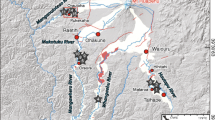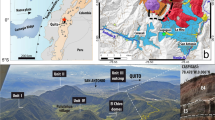Abstract
The 1886 eruption of Tarawera, New Zealand, was unusual for a Plinian eruption because it involved entirely basaltic magma, originated in a 17-km-long fissure, and produced extremely overthickened proximal deposits with a complex geometry. This study focuses on an 8-km-long segment cutting across Mount Tarawera where over 50 point-source vents were active during the 5.5-h eruption. A detailed characterization of the proximal deposits is developed and used to interpret the range of styles and intensities of the vents, including changes with time. We identify the four vents that contributed most heavily to the Plinian fall and evaluate the extent to which current volcanic plume models are compatible with the depositional patterns at Tarawera. Three proximal units are mapped that have phreatomagmatic, magmatic, and phreatomagmatic characteristics, respectively. Within the magmatic proximal unit, beds of like character are grouped into packages and delineated on scaled cross sections. Package dispersal is quantified by measuring the linear thickness half-distance (t1/2) in the planes of the fissure walls. Most packages have localized dispersals (low t1/2), indicating that Strombolian-style activity dominated most vents. The more widely dispersed packages (high t1/2) reflect contributions from additional transport regimes that were more vigorous but still contributed considerable material to the proximal region. We conclude that the geometry of the observed proximal deposits requires three modes of fall transport: (1) fallout from the upper portions of the Plinian plumes produced principally by vents in four craters; (2) sedimentation from the margins of the lower portions of the Plinian plumes including the jets and possibly the lower convective regions; and (3) ejection by weak Strombolian-style explosions from vents that did not contribute significant volumes of particles to the high plume. We suggest that the curvature of the velocity profile across the jet region of each plume (1–4 km height) was important, and that the lower velocity at the margins allowed proximal deposition of a large volume of material with a wide grain-size range.








Similar content being viewed by others
References
Andronico D, Branca S, Calvari S, Burton M, Caltabiano T, Corsaro R, Del Carlo P, Garfi G, Lodato L, Miraglia L, Mure F, Neri M, Pecora E, Pompilio M, Salerno G, Spampinato L (2005) A multi-disciplinary study of the 2002–03 Etna eruption: insights for a complex plumbing system. Bull Volcanol 67(4):314–330
Bonadonna C, Phillips J (2003) Sedimentation from strong volcanic plumes. J Geophys Res 108:2340–2368
Bonadonna C, Ernst GGJ, Sparks RSJ (1998) Thickness variations and volume estimates of tephra fall deposits: the importance of particle Reynolds number. J Volcanol Geotherm Res 81(3–4):173–187
Bullard FM (1947) Studies on Paricutin Volcano, Michoacan, Mexico. Geol Soc Am Bull 58:433–450
Bursik MI, Sparks RSJ, Gilbert JS, Carey SN (1992) Sedimentation of Tephra by volcanic plumes. 1. Theory and its comparison with a study of the Fogo-a Plinian Deposit, Sao-Miguel (Azores). Bull Volcanol 54(4):329–344
Calvari S, Pinkerton H (2004) Birth, growth and morphologic evolution of the ‘Laghetto’ cinder cone during the 2001 Etna eruption. J Volcanol Geotherm Res 132:225–239
Carey R (2002) A volcanological study of the proximal deposits from the 1886 Tarawera eruption. MSc Thesis, School of Earth Sciences, University of Tasmania, Hobart, Australia, p 103
Carey SN, Sigurdsson H (1982) Influence of particle aggregation on deposition of distal tephra from the May 18, 1980 eruption of Mount St. Helens volcano. J Geophys Res 87:7061–7072
Carey S, Sparks RSJ (1986) Quantitative models of fallout and dispersal of tephra from volcanic eruption columns. Bull Volcanol 48:109–125
Cashman K, Delgado H, Johnson E, Pioli L, Rosi M, Wallace P (2004) A new look at violent Strombolian eruptions: past behavior and future potential. Abstracts, IAVCEI General Assembly 2004, Pucon, Chile
Cole JW (1970) Structure and eruptive history of the Tarawera Volcanic Complex. NZ J Geol Geophys 13:879–902
Dobran F (2001) Volcanic processes: mechanisms in material transport. Kluwer, New York, p 590
Ernst GGJ, Sparks RSJ, Carey SN, Bursik MI (1996) Sedimentation from turbulent jets and plumes. J Geophys Res 101:5575–5589
Fedotov SA, Enman VB, Magus’kin MA, Levin VY, Zharinov NA (1978) Intrusion of basalts and the formation of feeder fissures for the great 1975 Tolbachik eruption, as inferred from geodetic data. Akademii Nauk Doklady Earth Sci Sect 229:43–46
Fierstein J, Hildreth W (1992) The plinian eruptions of 1912 at Novarupta, Katmai National Park, Alaska. Bull Volcanol 54:646–684
Fierstein J, Houghton BF, Wilson CJN, Hildreth W (1997) Complexities of plinian fall deposition at vent: an example from the 1912 Novarupta eruption (Alaska). J Volcanol Geotherm Res 76:215–227
Foshag W, Gonzales R (1956) Birth and development of Paricutin volcano. U S Geol Surv Bull 965(D):355–489
Heiken G, Wohletz K (1985) Volcanic Ash. University of California Press, Berkley, p 246
Heliker CC, Kauahikaua J, Sherrod DR, Lisowski M, Cervelli PF (2003) The Rise and fall of Pu‘u ‘O‘o Cone, 1983–2002. US Geol Surv Prof Paper No. 1676, USGS, Reston, VA, pp 29–51
Hildreth W, Drake RE (1992) Volcano Quizapu, Chilean Andes. Bull Volcanol 54:93–125
Holman J (1992) Heat transfer. McGraw-Hill, London, pp 713
Hort M, Gardner J (2000) Constraints on cooling and degassing of pumice during Plinian volcanic eruptions based on model calculations. J Geophys Res 105:25981–26001
Houghton BF, Wilson CJN (1998) Fire and water: physical roles of water in large eruptions at Taupo and Okataina calderas. In: Arehart GB, Hulston JR (eds) Water-rock interaction. Proceedings of the 9th International Symposium on Water-Rock Interaction, 30 March–3 April 1998, Taupo, New Zealand, AA Balkema, Rotterdam, pp 25–30
Houghton BF, Wilson CJN, Del Carlo P, Coltelli M, Sable JE, Carey RJ (2004a) The influence of conduit processes on changes in style of basaltic Plinian eruptions: Tarawera 1886 and Etna 122 BC. J Volcanol Geotherm Res 137:1–14
Houghton BF, Wilson CJN, Fierstein J, Hildreth W (2004b) Complex proximal deposition during the Plinian eruptions of 1912 at Novarupta, Alaska. Bull Volcanol 66:95–133
Hutton FW (1887) The eruption of Mount Tarawera. J Geol Soc Lond 43:178–189
Istituto Nazionale di Geofisica e Vulcanologia (INGV) (2001) Unita Funzionale Vulcanologia e Geochimica Report. Retrieved October 2005 from http://www.ct.ingv.it/Ufvg/Default.htm
Istituto Nazionale di Geofisica e Vulcanologia (INGV) (2002) Unita Funzionale Vulcanologia e Geochimica Report. Retrieved October 2005 from http://www.ct.ingv.it/Ufvg/Default.htm
Keam RF (1988) Tarawera: the volcanic eruption of 10 June 1886. Published by the author, Auckland, New Zealand, pp 472
Koyaguchi T (1994) Grain-size variation of tephra derived from volcanic umbrella clouds. Bull Volcanol 56:1–9
McClelland L, Simkin T, Sumners M, Nielsen E, Stein TC (eds) (1989) Global volcanism 1975–1985. Prentice-Hall and American Geophysical Union, AGU, Washington, DC, p 653
Nairn IA (1979) Rotomahana-Waimangu eruption, 1886: base surge and basalt magma. J Geol Geophys 22(3):363–378
Nairn IA, Cole JW (1981) Basalt dikes in the 1886 Tarawera Rift. NZ J Geol Geophys 24(5–6):585–592
Pyle DM (1989) The thickness, volume and grain-size of tephra fall deposits. Bull Volcanol 51:1–15
Richter DH, Eaton JP, Murata KJ, Ault WU, Krivoy HL (1970) Chronological narrative of the 1959–60 eruption of Kilauea volcano, Hawaii. U S Geol Surv Prof Paper No. 537-E, USGS, Reston, VA, p 73
Riedel C, Ernst GGJ, Riley M (2003) Controls on the growth and geometry of pyroclastic constructs. J Volcanol Geotherm Res 127:121–152
Sarna-Wojcicki AM, Shipley S, Waitt RB Jr, Dzurisin D, Wood SH (1981) Areal distribution, thickness, mass, volume, and grain size of air-fall ash from six major eruptions of 1980. In: Lipman PW, Mullineaux DR (eds) The 1980 eruptions of Mount St Helens, Washington. U S Geol Surv Prof Paper No. 1250, Reston, VA, pp 577–600
Scasso RA, Corbella H, Tiberi P (1994) Sedimentological analysis of the tephra from the 12–15 August 1991 eruption of Hudson volcano. Bull Volcanol 56:121–132
Scientific Event Alert Network (SEAN) (1988) Lonquimay (Chile) volcanic activity report. SEAN Volcanic Activity Reports 1988
Smith SP (1886a) The eruption of Tarawera: a report to the Surveyor General. NZ Government Printer, Wellington, New Zealand, pp 84
Smith SP (1886b) Preliminary report on the volcanic eruption at Tarawera. J House Represent 26:1–4
Sparks RSJ (1986) The dimensions and dynamics of volcanic eruption columns. Bull Volcanol 48:3–15
Sparks RSJ, Wright JV (1979) Welded air-fall tuffs. Geol Soc Am Spec Pap 180:155–166
Sparks RSJ, Wilson L, Sigurdsson H (1981) The pyroclastic deposits of the 1875 eruption of Askja, Iceland. Phil Trans R Soc London 229:241–273
Sparks RSJ, Bursik MI, Ablay GJ, Thomas RME, Carey SN (1992) Sedimentation of tephra by volcanic plumes. 2. Controls on thickness and grain-size variations of tephra fall deposits. Bull Volcanol 54:685–695
Sparks RSJ, Bursik MI, Carey SN, Gilbert JS, Glaze LS, Sigurdsson H, Woods AW (1997) Volcanic plumes. Wiley, Chichester, pp 574
Sumner JM (1998) Formation of clastogenic lava flows during fissure eruption and scoria cone collapse: the 1986 eruption of Izu-Oshima volcano, eastern Japan. Bull Volcanol 60:195–212
Thomas APW (1888) Report on the eruption of Tarawera and Rotomahana, NZ Government Printer, Wellington, New Zealand, pp 74
Tokarev P (1983) Calculation of the magma discharge, growth in the height of the cone and dimensions of the feeder channel of crater 1 in the Great Tolbachik fissure eruption, July 1975. In: Fedotov S, Markhinin Y (eds) The Great Tolbachik fissure eruption. Cambridge University Press, Cambridge, pp 27–35
Walker GPL (1980) The Taupo Pumice: product of the most powerful known (ultraplinian) eruption? J Volcanol Geotherm Res 8:69–94
Walker GPL, Self S, Wilson L (1984) Tarawera 1886, New Zealand: a basaltic plinian fissure eruption. J Volcanol Geotherm Res 21:61–78
Williams WL (1887) Phenomena connected with the Tarawera eruption of 10th of June as observed at Gisborne. Trans NZ Inst 19:380–382
Wilson L (1972) Explosive volcanic eruptions. II. The atmospheric trajectories of pyroclasts. Geophys J R Astron Soc 30:381–392
Yasui M, Koyaguchi T (2004) Sequence and eruptive style of the 1783 eruption of Asama Volcano, central Japan: a case study of an andesitic explosive eruption generating fountain-fed lava flow, pumice fall, scoria flow and forming a cone. Bull Volcanol 66:243–262
Acknowledgements
This research was supported by NSF grant EAR01-25719. We thank Michael Rosenberg of IGNS, Wairakei, for invaluable assistance in the field and lab. CJNW thanks the UK NERC and the New Zealand Foundation for Research, Science & Technology for financial support. The manuscript benefited greatly from the constructive comments of Costanza Bonadonna, Takehiro Koyaguchi, Steve Self, and James White. We also thank Gary Barnes, Julia Hammer, Andrew Harris, and Don Swanson for thorough and helpful comments on the draft manuscript.
Author information
Authors and Affiliations
Corresponding author
Additional information
Editorial responsibility: J. White
Rights and permissions
About this article
Cite this article
Sable, J.E., Houghton, B.F., Wilson, C.J.N. et al. Complex proximal sedimentation from Plinian plumes: the example of Tarawera 1886. Bull Volcanol 69, 89–103 (2006). https://doi.org/10.1007/s00445-006-0057-6
Received:
Accepted:
Published:
Issue Date:
DOI: https://doi.org/10.1007/s00445-006-0057-6




